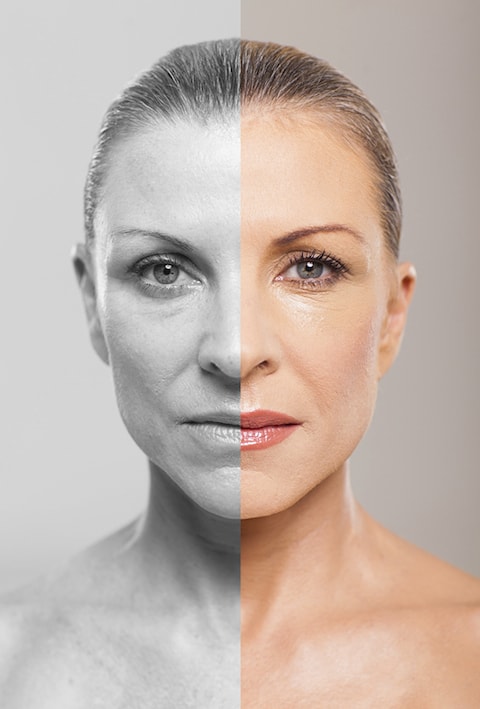
There is a growing sector in the tattoo industry that has art imitating life and concealing tragedies. Cosmetic tattooing has been around for some years now, but new applications for inking the skin have popped up every day. The latest adaptation of tattooing has been geared towards helping burn victims.
Basma Hameed and Cosmetic Tattooing
Basma Hameed of the Basma Hameed Clinic in Toronto, Canada has taken her practice to the forefront of cosmetic tattooing by reinstating the discolored pigment of burn scars back to their previous natural and healthy appearance.
When she was a young girl, Basma Hameed was accidentally burned by hot oil in a cooking accident. After more than 100 surgeries and 20 plus years, she still needed to conceal the after-effects of the trauma and subsequent treatments. That’s when she discovered tattooing as a way of camouflaging the scars and discoloration so that the scar pigment could match her natural skin tones. Hameed trained to hone her technique and color matching skills in the field of cosmetic tattooing in order to offer the same treatment to her patients that benefitted her in the past. She has also started her own line of cosmetic makeup to help burn victims as well.
This isn’t an isolated case of art being used in the medical field. Victims of breast cancer who have undergone a mastectomy have been using tattoos to transform their bodies for many years. By allowing elaborate, artful tattoos to hide the scars of their surgery, women have turned their tragedies into badges of honor. Even further, cosmetic surgeons have also used the tattooing of tiny dots on the skulls of patients that mimic the appearance of hair follicles that give the look of a fuller mane.
With all of these treatments being offered via a tattoo gun, it is no wonder why the once frowned upon practice has now become a widely accepted and admired form of expression and change.
How is Cosmetic Tattooing Performed?
The surgeon evaluates the scar at the beginning of each session and chooses a color or custom blend color to best match the natural skin tone of the patient. Prior to the procedure, a topical anesthesia is applied to ensure the comfort of the patient during the procedure. A natural mineral-based pigment is deposited into the scar using proprietary equipment that houses acupuncture needles that gently vibrates on the dermal layers of the skin. The pigment is deposited into the scar until the desired color and subtle gradient shading is achieved. A minimum of four sessions is needed on each scar to achieve the final results. Each session is scheduled four weeks apart.
Following the procedure, there will be some temporary swelling and redness which may take several days to dissipate depending on the area of the body, how much pigment is applied and the general health of the skin. Immediately after the procedure, the color will appear stronger compared with how it will eventually look. Within a few days, the skin will start to slightly exfoliate and the color will become lighter. This will continue until the intended shade is achieved. No makeup should be worn on the pigmented skin for at least seven days after each session. Multiple sessions are needed in order to match the color. During each session, a pigment is blended into the skin in layers. Some of the pigment exfoliates after each session so a series of sessions are necessary to build the color into, and around, the scar to match the natural skin color.
Additional Medical Uses for Cosmetic Tattooing
Permanent eyebrow makeup is a form of cosmetic tattooing which makes use of tattoos (permanent pigmentation of the dermis) as a means of producing designs that look like makeup such as eye lining and other permanent enhancing design to the skin of the face, lips and eyelids. It is also used to produce artificial eyebrows particularly in individuals who have lost them as a consequence of old age, diseases (alopecia totalis, chemotherapy or a genetic disturbance) and to disguise scars and white spots in the skin such as in vitiligo.
For the majority of patients who undergo a mastectomy procedure, the nipple and areola are removed. Therefore, many women choose to undergo nipple reconstruction surgery. After breast reconstruction surgery which rebuilds the breast mound, a nipple reconstruction procedure attempts to recreate the darker-colored areola and the elevated nipple. As part of the breast reconstruction procedure, many patients want their areola color to match their new breast. Cosmetic tattooing is one of the various methods of nipple reconstruction. During the treatment, the tattoo artist or surgeon will measure and outline the nipple area. Organic pigment is then embedded beneath the skin to create a natural, permanent nipple and areola.
Like any other cosmetic procedure, there are a couple of risks associated with cosmetic tattooing and they include infection, allergic reaction and granuloma and keloid formation.
Can Cosmetic Tattooing Fade
Be aware that certain products, such as those containing aloe vera, Retin A or glycolic acid, can cause the tattoo to fade more quickly. In fact, the pigment will fade by about 50\\% after the first week of treatment and may require a yearly touch-up. This is especially true if the patient is fair-skinned. Patients should consult with a board-certified doctor to determine if cosmetic tattooing is the best option to achieve their desired results.